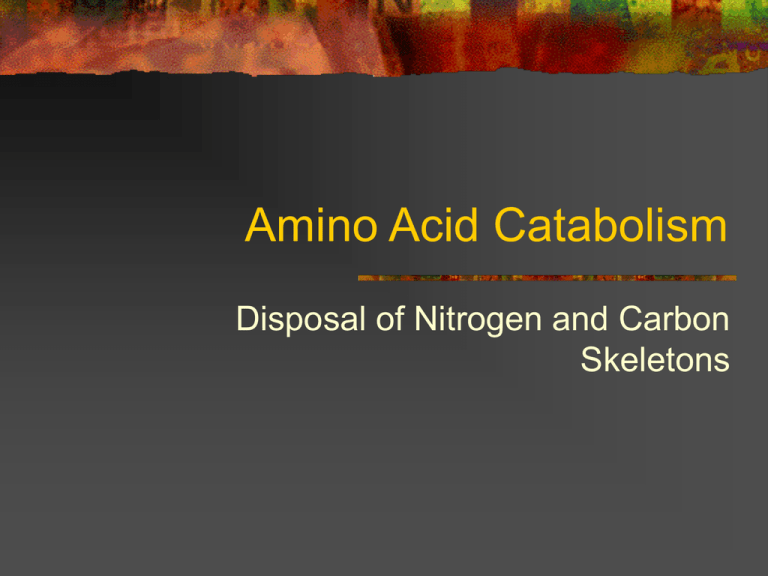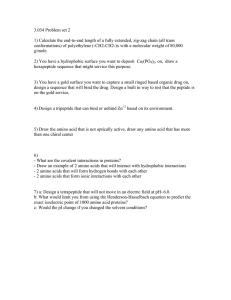Amino Acid Catabolism Disposal of Nitrogen and Carbon Skeletons
advertisement

Amino Acid Catabolism Disposal of Nitrogen and Carbon Skeletons Clinical Case Study Male infant, 2.9 kg at birth, healthy Day 3 - seizures Mother with history of aversion to meat vomiting and lethargy plasma [NH4+] = 240 uM (25-40 normal) hyperammonemia mild alkalosis (pH=7.5, normal 7.35-7.45) Clinical Case Study Plasma AA gln = 2400 uM (350-650) ala = 750 uM (8-25) arg = 5 uM (30-125) cit = undetectable Urinary orotic acid = 285 ug/mg creatinine (0.3-10) Clinical Case Study Oral therapy initiated EAA + arginine Sodium benzoate Patient improves after 7 days Plasma [NH4+] normalized Overview of Amino Acid Catabolism: Interorgan Relationships Overview of Amino Acid Catabolism: Interorgan Relationships Intestine Dietary amino acids absorbed Utilizes glutamine and asparagine as energy sources Releases CO2, ammonium, alanine, citrulline as endproducts Utilizes glutamine during fasting for energy Dietary amino acids and catabolites released to portal blood Enteral Formulas containing glutamine JUVEN is a therapeutic nutritional that contains a patented blend of arginine, glutamine, and HMB (beta-hydroxy-betamethylbutyrate). JUVEN has been clinically shown to help build lean body mass (LBM),1,2 enhance immune response,2 and promote collagen synthesis Overview of Amino Acid Catabolism: Interorgan Relationships Liver Synthesis of liver and plasma proteins Catabolism of amino acids Gluconeogenesis Ketogenesis Branched chain amino acids not catabolized Urea synthesis Amino acids released into general circulation Enriched (% of total aa) in BCAA (2-3X) Overview of Amino Acid Catabolism: Interorgan Relationships Skeletal Muscle Muscle protein synthesis Catabolism of BCAA Amino groups transported away as alanine and glutamine (50% of AA released) Alanine to liver for gluconeogenesis Glutamine to kidneys Kidney Glutamine metabolized to a-KG + NH4 a-KG for gluconeogenesis NH4 excreted or used for urea cycle (arginine synthesis) Important buffer preventing acidosis [NH4+] : [NH3] = 100 : 1 Overview of Amino Acid Catabolism: Interorgan Relationships Vitamin-Coenzymes in Amino Acid Metabolism Vitamin B-6 (pyridoxal phosphate) Folic acid (tetrahydrofolate) Vitamin B-12 Vitamin-Coenzymes in Amino Acid Metabolism Vitamin B-6 : pyridoxal phosphate Enzymes that bind amino acids use PLP as coenzyme for binding Transaminases Amino acid decarboxylases Amino acid deaminases Vitamin-Coenzymes in Amino Acid Metabolism Folacin: Tetrahydrofolate (THF) Carrier of single carbons Donor & receptor Glycine and serine Tryptophan degradation Histidine degradation Purine and pyrimidine synthesis Vitamin-Coenzymes in Amino Acid Metabolism Vitamin B-12 Catabolism of BCAA Methyl-malonyl CoA mutase (25-9 &10) Vitamin-Coenzymes in Amino Acid Metabolism Vitamin B-12 Methionine synthesis/recycling Methionine as a methyl donor Choline and creatine synthesis Homocysteine is product HCys -> Met requires B12 Figure 26-4 Overview of Amino Acid Catabolism: Interorgan Relationships How does this occur? Disposal of Amino Acids Nitrogen: Key reactions Transamination reactions Deamination reactions Glutamate dehydrogenase Hydrolytic deamination Glutaminase Glutamine synthesis Disposal of Amino Groups: Transamination Reactions Often the first step of amino acid degradation Transfer of amino group from many amino acids to limited number of keto acid acceptors Pyruvate <-> alanine Oxaloacetate <-> aspartate Alpha-keto-glutarate <-> glutamate Disposal of Amino Groups: Transamination Reactions Transamination reactions tend to channel amino groups on to glutamate Glutamate’s central role in amino acid N metabolism Disposal of Amino Groups: Transamination Reactions Transaminase reactions are reversible ALT = SGOT ALA important in muscle where ~25% of AA-N is transported out on ALA In liver, reverse reaction moves AA-N back on GLU AST = SGPT ASP important in liver since half of urea-N is from ASP Disposal of Amino Groups: Deamination Reactions Glutamate dehydrogenase oxidative deamination Important in liver where it releases ammonia for urea synthesis Hydrolytic deamination Glutaminase & asparaginase Disposal of Amino Groups: Glutamine Synthetase Important plasma transport form of nitrogen from muscle Detoxification of ammonia Brain Liver Removes ammonia intestinal tract Bacterial deamination of amino acids Glutamine utilization in intestinal cells Overview of Amino Acid Catabolism: Interorgan Relationships Movement of amino acid nitrogen: post-absorptive and fasting states From extra-hepatic tissues (muscle) to liver Site of gluconeogenesis and ketogenesis Site of urea synthesis All amino acids present in plasma but enriched (~50%) in alanine and glutamine Production of ALA & GLN in extrahepatic tissues Transamination of AA to form GLU Formation of ALA AA + aKG <-> aKA + GLU GLU + pyr <-> aKG + ALA Formation of GLN GLU <-> aKG + NH3 NH3 + GLU -> GLN Overview of Amino Acid Catabolism: Interorgan Relationships Detoxification of Ammonia by the Liver: the Urea Cycle Amino acid N flowing to liver as: Alanine & glutamine Other amino acids Ammonia (from portal blood) Urea chief N-excretory compound Detoxification of Ammonia by the Liver: the Urea Cycle Contains all enzyme of urea cycle Site of urea synthesis Kidney has all urea cycle enzymes except arginase Site of arginine synthesis Mitochondria CPS regulatory enzyme Flow of Nitrogen from Amino Acids to Urea in Liver Amino acid flow from muscle to liver Alanine & glutamine Liver Transfers N to GLU GLN’ase & GDH Transaminases Transfers GLU-N to: ASP AST Transamination route NH3 GDH Trans-deamination route GLN’ase Transfers N to urea Ammonia detoxification by the liver Liver very effective at eliminating ammonia from blood Periportal hepatocytes Portal blood ammonia = 300 – 1000 uM Systemic blood ammonia = 20uM Urea synthesis Km CPS ~ 1mM Perivenous hepatocytes Glutamine synthesis Very low Km for ammonia Removes any NH3 not removed by periportal hepatocytes Clinical Case Study Male infant, 2.9 kg at birth, healthy Day 3 - seizures Mother with history of aversion to meat vomiting and lethargy plasma NH4+ = 240 uM (25-40 normal) hyperammonemia mild alkalosis (pH=7.5, normal 7.35-7.45) Clinical Case Study Plasma AA gln = 2400 uM (350-650) ala = 750 uM (8-25) arg = 5 uM (30-125) cit = undetectable Urinary orotic acid = 285 ug/mg creatinine (0.3-10) Resolution of Clinical Case Diagnosis of neonatal hyperammonemia symptoms blood ammonium concentration Defect in urea cycle elevated glutamine and alanine low or absent arginine and citrulline Detoxification of Ammonia by the Liver: the Urea Cycle Resolution of Clinical Case Genetic deficiency of ornithine transcarbamoylase urinary orotic acid CP spills into cytosol where enters pyrimidine biosynthetic pathway, orotic acid an intermediate in the pathway Resolution of Clinical Case source of orotic acid Clinical Case Study Treatment Oral therapy essential amino acids arginine sodium benzoate @7 days clinically well normal NH4+ Resolution of Clinical Case: Treatment Essential Amino Acids Arginine w/o urea cycle, becomes essential Benzoic acid conjugates with glycine and excreted in urine as hippuric acid glycine in equilibrium with ammonia Glycine synthase CO2 + Me-THF + NADH + NH3 => glycine removal results in reducing ammonia levels Resolution of Clinical Case: Genetics Gene for OTC found on X-chromosome Women are carriers usually asymptomatic may experience migraines, vomiting, lethargy when eating high protein meals (meat) OTC deficiency most common (but rare) disorders of the urea cycle (1: 20-80,000)



